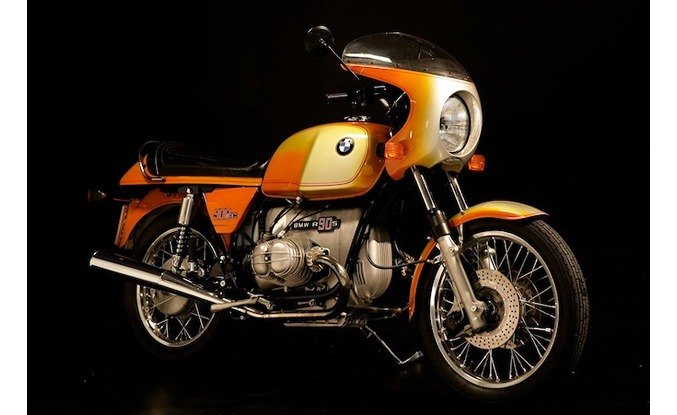The Falloon Files: 1973 BMW R90S
In 1973 I started looking at streetbike magazines as well as dirtbike magazines on the Lyons Drug magazine rack; there must have been 20 or 30, and plenty of time to browse as there was no www, and very little hope of getting a motorbike anytime soon. The 1973 BMW R90S was a piece of pure unobtanium, from a planet far, far away, that completely knocked my striped socks off. Ian Falloon wrote an entire 128-page book about it.
Some motorcycles redefine the perception of a brand. Prior to the release of the R90S in late 1973, BMW motorcycles were considered heavy, conservative and obviously uninspiring. A BMW was great for hauling sidecars or undertaking long cross-country trips, but it was hardly a sports bike. If you were under forty it just wasn’t cool to be seen riding a BMW, but the R90S changed that. In its day, the R90S offered unparalleled performance on the road, but even more important than performance was style. The R90S was the first production motorcycle to come standard with a factory-fitted fairing. And if the cafe-racer look wasn’t enough to make the R90S stand out from the crowd, the paint scheme was. Early examples came in smoked black and from 1975 Daytona Orange was an option. With hand-painted stripes and an exorbitant price tag, there was nothing else quite like the R90S back then. It was the motorcycle that embodied the era. The emphasis on style was on the rise, and the R90S was marketed as a luxury accessory for the new breed of affluent motorcyclist.
The R90S engine was based on the R90/6 touring model. Released simultaneously, it was a development of the new generation R75/5 introduced in 1969, but incorporating a five-speed gearbox and larger alternator for more reliable starting. While the oversquare 90×70.6mm dimensions were shared between the 90/6 and 90S, the R90S had higher compression pistons (9.5:1) and larger carburetors to develop its 67 horsepower at 7 000 rpm. Rather than the ubiquitous Bing carburetors, Italian Dell’Orto PHM38mm carburetors with accelerator pumps powered the R90S. But while the Italians continued to install noisy anti-social mufflers, the R90S remained silent, up to the top speed of around 200 km/h. It was also easy to live with, with most maintenance tasks within the owner’s reach. Easily adjustable tappets actuated the overhead valves, while ignition was by points conveniently located at the front of the engine.
Twin 260mm disc brakes also set the R90S apart, though ATE’s single-piston floating brake calipers lacked ultimate power. The master cylinder was also oddly mounted below the fuel tank, operated by a Bowden cable from the handlebar lever. This was designed to protect the master cylinder in the event of a crash, but the result was a remote, spongy action. With its shaft drive and long-travel suspension, the R90S may have lacked the sharpness and handling precision of comparable Italian sportsters, but it more than made up for it in civility. Several practical features never before seen on motorcycles were included.
Instrumentation inside the beautifully finished fairing included a clock and ammeter. Out of sight was a three-way adjustable hydraulic steering damper and as far as the toolbox goes, the R90S left every other bike in the shade. Not only complete, this included an official BMW towel, tire repair patches and an underseat tire pump. The rims were aluminum and the build quality and finish was second to none.
But the R90S wasn’t just style without substance. On the road, he excelled. The chassis, with its bolt-on rear subframe, may have been deemed insufficient in terms of ultimate strength, but in most cases it was more than sufficient. The long-travel suspension provided a plush ride but was also damped enough for a spirited ride. The moderate wet weight of 215kg and reasonable wheelbase of 1465mm contributed to a manageable package without being heavy. The 24 liter fuel tank also offered a range of nearly 400 kilometers and the level of comfort was unmatched.
The R90S was an instant hit. Over a three-year period, BMW sold as many as it could make, building 17,455 before the R100S replaced it in 1977. But it’s the R90S that stands out and is remembered now. Unquestionably the classic BMW motorcycle of the modern era, the R90S was BMW’s first, and arguably its best Superbike of all time. And it’s a classic case. More expensive than the Ducati 750 SS “Green Frame” at the time, the R90S is now the most affordable Exotic Superbike of the 70s.

ISBN-13: 978-1884313943
We are committed to finding, researching and recommending the best products. We earn commissions on the purchases you make using the retail links in our product reviews. Learn more about how it works.
Become a Moto.com initiated. Get the latest motorcycle news first by signing up to our newsletter here.




Comments are closed.